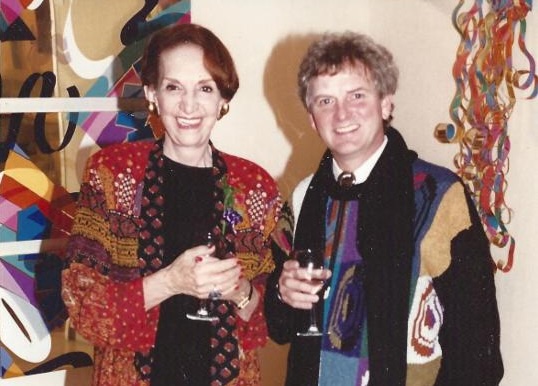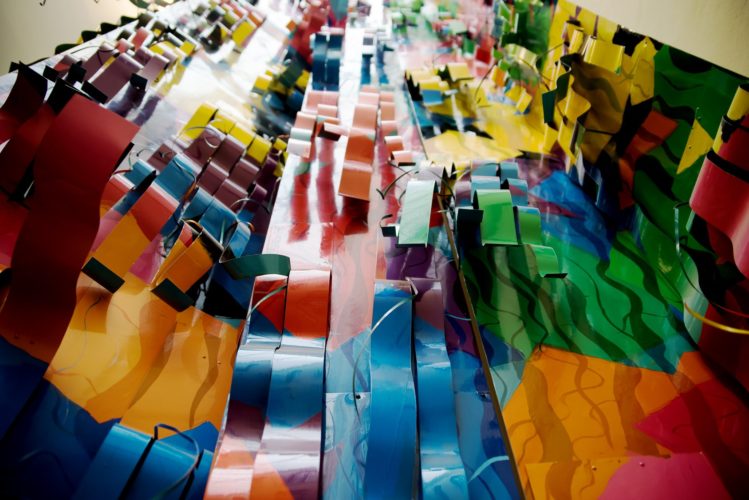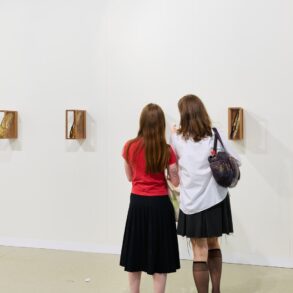
WILMINGTON — Ribbons of aluminum cascade down one of Thalian Hall’s walls, brightly colored in enamel: red, blue, yellow, green, pink. Each was bent to create a wave of kaleidoscopic joy for onlookers.
CATCH UP: More art news in the region
A few blocks over in the Wilson Center lobby, hand-curled ribbons create individual bobbles — starbursts that hang from the ceiling, twisting and turning, as if dancing to create shadows against the sunlight.
These are only two places to view Dorothy Gillespie’s sculptures, many of which are on display at other venues across town — UNCW, Cameron Art Museum, New Hanover County Arboretum, Novant NHRMC, Glow Academy, and DREAMS Center for Arts Education. In fact, Gillespie’s son, Gary Israel, confirms the Port City houses the most of the world-renowned artist’s public art.
Wilmington plays a role in how Gillespie’s work became revered worldwide. It’s part of a new documentary, “Dorothy Gillespie: Courage, Independence, and Color,” which will have its premiere in Thalian Hall Friday night.
“Dorothy Gillespie pioneered new directions for metal sculpture and is best known for her large-scale, colorfully painted cuts of aluminum strips that radiate, undulate, or curl in giant arrangements of ribbon, enchanted towers, or bursting fireworks,” according to Art in Bloom Gallery owner Amy Grant, who helped secure Wilmington as the film’s premiere destination.
Created by filmmakers Jay Scala and Crystal White of White Ladder Productions, with help from Israel — president of the Dorothy Gillespie Foundation — 90 minutes explores the artist’s early beginnings as a painter before becoming a sculptor. It also covers the day-to-day balance of being a female artist in the 1940s, rearing a family and growing into one of the most prominently displayed public artists worldwide.
“My mother was a very independent woman,” Israel told Port City Daily on a phone call Tuesday. “She really wanted it all and she did it all: had three children, had a career, had three nightclubs that she and my father owned over the years. She had a radio show. She taught in universities. So it’s a model for young women artists today.”
Gillespie’s career began as a two-dimensional artist, with a focus on abstract work. She began painting in youth in Roanoke, Virginia, where she grew up. Her inspiration in art evolved from the colors of a Christmas tree and hues from children’s toys, like spinning tops and bouncy balls, as she described in a 12-minute documentary, “In Her Own Words.”
A series of four videos were recorded over 40 years by PBS Virginia and are shown in classes and at museums today. But Israel wanted to share his mother’s story on a larger platform. The goal after debuting the documentary in Wilmington, he said, is to put it on the festival circuit and potentially shop it to streamers.
First and foremost, though, he wants it to serve as a message on how education is important to an artist.
Against her parents’ wishes, Gillespie pursued art at both Radford University and the Maryland Institute College of Art before moving to New York City. Her first day there in 1946 she met Bernard Israel — whom she called “Bunny” and ended up marrying. They had three children, ran restaurants and clubs in Greenwich Village and Miami.
Gillespie painted part-time and had her first break at Cherry Lane Theater — the oldest continuously running off-Broadway theater in New York City — which often brought in many famed actors of the day. Israel said that break, at only 26, gave his mother the confidence to continue forging her own artistic path.
“In the ‘40s, if you were a female artist and you were not known as a partner or a spouse of a male artist, you would never get a show in a museum or a gallery,” Israel explained.
Gillespie ran in the same circles as William de Kooning — “Mother was friends with his wife, Elaine,” Israel said — Lee Krasner and Jackson Pollock. Her studio was in the West Village, whereas most female artists had studios in the East Village. Though Gillespie had gallery shows here and there, her first mural in the SoHo area on Houston Street — commissioned for International Women’s Year, 1975 — really propelled her to do more public art.
“And that was a very important period,” Israel said. “A man came up to her when she was looking at the mural and asked who did that and she said she did. He was flabbergasted because he didn’t think a woman could do that size of artwork.”
From that moment on, Israel said his mother’s signature included her first name, too: “Dorothy” rather than just “Gillespie.”
“She always used to tell her students: ‘Make sure you sign your work with your first name so that people know that it was done by a woman,’” he said.
Gillespie was one of many women who helped organize the Women’s Interart Center in New York, a feminist-oriented organization for women in the arts in 1969, to foster innovation and exhibitions. The documentary includes her impact and rise in the art world, covering the artist’s progression from 2D painting to 3D installations. She showcased her sculptures everywhere from Central Park to Rockefeller Center, Epcot to the World Trade Center.
“My mother felt museums are great — and her art is in lots of museums around the world,” Israel clarified, “but she felt that museums also limited who could see her works. So I think when all is said and done — and you can put your money on this — her art will have been seen by more people in the public than any female artist in American history. When I tell people that, they’re shocked because they say, ‘Well, what about Georgia O’Keeffe? Louise Nevelson, all those famous women artists?’”
Israel said his goal is to ensure most of his mother’s art remains in the public domain — ”where children and anyone can see, appreciate and enjoy it.”
The filmmakers interviewed 40 people for “Dorothy Gillespie: Courage, Independence, and Color,” including Joanne Ryan of Caldwell University and Leslie King-Hammond of Maryland Institute College of Art. Both women worked with Gillespie to help advance art education in colleges and universities.
“We were particularly lucky to speak with the great gallerist, Gertrude Stein, who hung out with Dorothy in the Salle de Champagnes in Greenwich Village and helped promote the No! Art Movement and Dorothy’s work with them,” filmmaker Crystal White said. “These women, and others, provided wonderful context and perspective on her life.”
Gillespie eventually co-founded a class, “Functioning in the Art World,” with American abstract expressionist Alice Baber, who worked in oils and watercolors, and Ruth Van Doren, who did quilted and painted textiles. The class focused on women operating “as professionals within a complex, male-dominated art world,” according to White.
She said hundreds of women would attend the workshops, many moving on to become artists, gallerists and educators, inspiring thousands more women.
“With all of the challenges that women continue to face in the world today, we felt that this was a timely story we had to tell,” White said.
The film took more than a year and half to complete, funded by Israel, The Dorothy M. Gillespie Foundation, and White Ladder Productions. White said she and Scala first learned of Gillespie several years ago after creating a short film about her studio in Narrowsburg, New York, for the foundation.
They were invited back to photograph the reception for Dorothy Gillespie’s 2019 retrospective at the Riggs and Leidy Galleries of the Fred Lazarus IV Center at Maryland Institute College of Art. That’s when talks about this new documentary began.
White said while most of Gillespie’s closest friends and family members had passed on and couldn’t be interviewed, there were others that bring her life to the screen and convey her indelible imprint. This includes never-before-heard interviews with Albert Michaels of State University of New York at Buffalo, as well as footage of “Functioning in the Art World,” produced and provided by The New School for Social Research in New York City.
“These scenes provide a rare look into her personality and worldview that one cannot access from her art alone,” White said.
Local interior designer Frances Hawk was also interviewed. Hawk attended a lecture Gillespie was giving at UNCW 40 years ago and became a close friend to the artist.
Wilmington ties

In 1974, a young budding actor, Tony Rivenbark — who graduated from College of Wilmington — was working on Broadway. Rivenbark happened to meet Gillespie, who hired him to paint her art studio. This led to a lifelong friendship, as Rivenbark eventually became the artist’s assistant.
Rivenbark moved back to Wilmington to oversee Thalian Hall and help restore it from its 1858 foundation and it became North Carolina’s revered, historical performance arts venue. In it, Rivenbark included works by Gillespie, including the 40-foot “Beanstalk: Colorfalls I,” which has been on display in the lobby since the 1990s.
When Rivenbark passed away from cancer in 2022, Grant helped clear his apartment and came across more treasured items from his friendship with Gillespie.
“He had this really cool photo he had taken of the ravioli cans that Dorothy Gillespie used for her paint,” she told PCD last year. “He had another photo framed of the very first show they worked on together in 1977. It was for her new art: the 3D rolled paper.”
Not only was Gillespie tied to Wilmington through her friendship with Rivenbark, she had a second home in the Port City for years and was a featured artist in 1982’s St. Thomas Celebration of the Arts — the first art museum in Wilmington before CAM opened. Gillespie’s centennial was even celebrated locally in 2021 at multiple places.
“That’s one of the reasons why I felt Wilmington would be an important part of this legacy,” Israel said about the documentary’s local debut.
Gillespie passed away in 2012 at 92. Israel said she was tired, losing her sight but still with it mentally and physically. However, she could no longer bend the metal as she once did.
“It’s a physically taxing skillset,” he said. “But she told me one day: It’s time for me to go.”
He thought she wanted to leave the assisted living facility she had chosen, as she refused to live with her children, Israel explained.
“I thought you didn’t want to go back to New York City?” he recalled asking her. “And she said, ‘No, no, no — it’s time for me to die.’ I told her we don’t make that decision.”
But even through death, Gillespie’s independence remained strong.
“She refused to eat, no matter how much we begged her,” Israel said. “And two months later, she passed away.”
Israel inherited the foundation upon his mother’s passing in 2012. At the time, she had two studios full of artwork. He consolidated it to one in the Catskills, which continues to open to the public.
Scholarships and grants, overseen by the Dorothy Gillespie Foundation, often go to women’s organizations, while the art continues to be sent to galleries, museums and public spaces.

“I’ve sold the art but I’ve mostly donated and loaned the art around the country,” Israel said.
The amount left behind continues to change as he locates more of his mother’s work. He said behind Wilmington, Broward College in Florida — also where Gillespie had a home — has five pieces on campus.
Israel met with UNCW Chancellor Aswani Volety last fall, he indicated.
“I’d like to continue to strengthen the relationship between the foundation and UNCW,” Israel said. “That’s a very important part of my mother’s legacy: education. She was a Woodrow Wilson Teaching Fellow and would go around to small colleges during the summer to work with students.”
He surmises more than 30 campuses feature Gillespie’s work today.
The family also has donated two new pieces in Wilmington: to the city’s new headquarters, Skyline Center, and another piece to go into Thalian Hall.
“Winter Jazz” — originally commissioned by the Neiman Marcus department store but obtained by the family at an auction — is 30 inches in diameter (52-inches tall by 22-inches wide) and sits on a pedestal on Thalian Hall’s third floor. But it will be installed at a new location in the building in coming months.
It’s a fitting piece for the venue as it was inspired by Gillespie’s love for the musical “The Phantom of the Opera,” covered in silver, gold and black. It’s been on display locally at CFCC’s Wilma Daniels Gallery and UNCW’s Cultural Arts Building.
“Working Together” is a 15-feet-tall, three-paneled wall sculpture, the aluminum painted in various pastels and golds. It will go on display on the first floor of the Skyline Center and originally hung at Radford University.
The screening of “Dorothy Gillespie: Courage, Independence, and Color,” will take place April 19, 7:30 p.m., and April 21, 2:30 p.m., with tickets available from $37 to $58. There will be a question-and-answer with the filmmakers following the documentary.
Tips or comments? Email at info@portcitydaily.com
Want to read more from PCD? Subscribe now and then sign up for our morning newsletter, Wilmington Wire, and get the headlines delivered to your inbox every morning.
This post was originally published on this site be sure to check out more of their content







